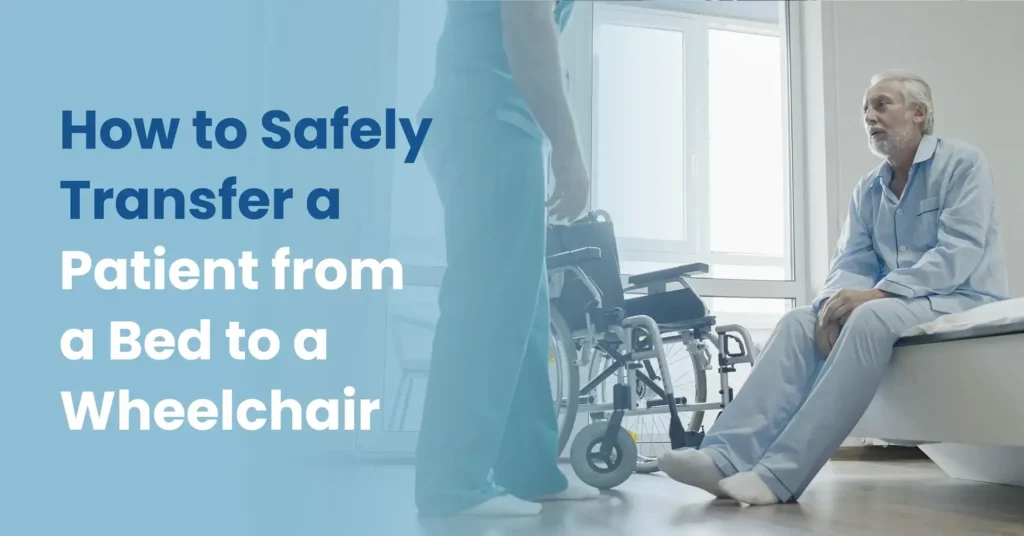Moving someone from bed to a wheelchair must be done with lots of care. This task requires strength and technique. Proper methods prevent injuries for everyone involved. This guide provides clear and safe steps. You will learn the correct transfer process. We will also discuss choosing the right equipment. Understanding different types of wheelchairs is very important. This knowledge ensures a good fit for the user.
Understanding Your Equipment
First you must know about the wheelchair. A standard one is not just a seat. It is a complex mobility device. Its design supports safe and independent movement. You might see a portable wheelchair that folds easily. This is great for travel and storage. Another option is a transport chair. It is crucial to know the difference.
A transport chair vs wheelchair comparison is helpful. A traditional wheelchair is self-propelled. The user moves the large rear wheels themselves. A transport chair has four small wheels. It is always pushed by a caregiver. A transport chair is lighter. But it offers less independence to the user.
You should also consider size. How wide is a wheelchair? Standard wheelchairs are about 25 inches wide. This width must fit through your home’s doorways. Measure your doors before you buy. A wheelchair that is too wide causes problems. It will not navigate the home safely.
Finding a wheel chair for sale is easy. You can search for a wheelchair store near me. A mobility store near me will have experts. They can help you choose the correct model. How much does a wheelchair cost? Prices vary a lot. A basic model may cost a few hundred dollars. A specialized power chair costs much more. Your insurance might cover some costs.
Setting the Stage for a Safe Transfer
A successful move begins long before you lift. Thoughtful preparation is your greatest tool. It ensures the entire process is secure and smooth. Start by gathering your essential supplies. The most important item is a gait belt. This strap wraps around the patient’s waist. It provides safety and convenience.
Check for the patient’s footwear. Sturdy shoes with non-slip soles are mandatory. Slippers or socks can be hazardous. Next, turn your attention to the wheelchair. Position it strategically beside the bed. A forty-five degree angle is often perfect for pivoting.
Engage the wheel locks immediately. This simple action, often called setting the brakes, is vital. Always test them with a firm push. Do not forget to swing the footrests up and out of the way. They are a common tripping obstacle. Finally, assess the bed height. An ideal position allows the patient’s feet to rest flat. Their knees should be at a comfortable right angle. This stable base is the foundation for a safe stand.
Executing the Safe Transfer
Now you are ready to move. Stand next to the patient. Place the gait belt around their waist. You should be able to slide two fingers underneath. This ensures to not place too tight. Position their feet firmly on the floor. Their feet should be shoulder-width apart. This creates a stable base.
Help patient to sit on the edge of the bed. It’s called dangling. Let them sit here for a minute. It helps to get rid of low blood pressure. Dizziness can happen when standing up too fast. Stand close to the patient. Position your own feet for balance. Do not bend at your waist. Your back must remain straight.
Hold the gait belt with both hands. Use an underhand grip for more security. Count to three out loud. On three, help the patient stand up. Use the strength in your legs to push up. Do not use your back muscles. Guide the patient to pivot their body. Their back should now be facing the wheelchair seat.

Lower them slowly into the wheel chair. Bend your knees again as you help them sit. Make sure they are positioned well back in the seat. Check their posture and comfort. Finally, place their feet on the footrests. You can now unlock the wheels. You are ready to drive wheelchair to your destination.
Special Considerations and Tips
Some situations require extra attention. A patient with very weak legs needs more help. A mechanical stand-assist device might be necessary. These devices provide lift support. They greatly reduce physical strain on the caregiver. Consult a physical therapist for advice. They can train you on specialized equipment.
What if the patient starts to fall? Do not try to stop their fall completely. This could injure you both. Instead, ease them down to the floor. Try to guide them toward a soft surface. Protect their head from hitting anything hard. Stay calm and call for help if needed.
Practice is essential for safety. Practice the transfer when you are not rushed. A physical or occupational therapist can observe you. They can provide feedback on your technique. Their expertise ensures you follow best practices. This builds your confidence and skill.
Conclusion
Transferring a patient safely protects everyone. It prevents serious injuries to the caregiver. It also maintains the patient’s dignity and comfort. Always prepare your equipment and environment. Use gait belt for security. Lift with your legs and keep your back straight. Clear communication is just as important as physical strength.
Choosing the right wheel chair is a basic step. Understanding different models is necessary. Ensure it fits your home’s layout. Don’t go for something that doesn’t fit to your needs. It creates a safer and more independent life for the patient. This guide provides a strong knowledge for that process. Your care and attention will work for you.

